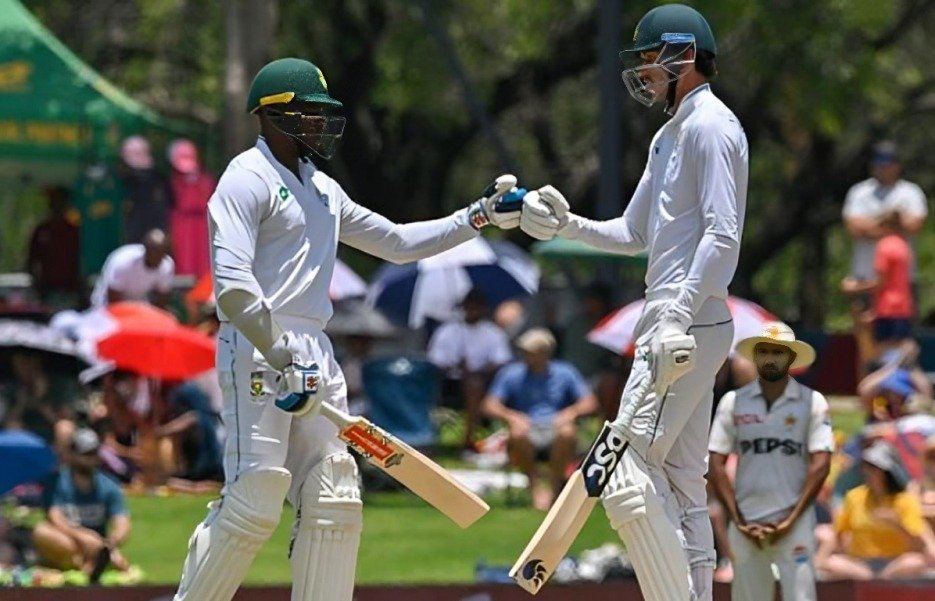South Africa Didn’t Go Away, yet Pakistan Dominates with Unstoppable Batting In Lahore’s Gaddafi Stadium, the first Test between Pakistan and South Africa began with an unusual twist: spinners dominated the bowling attack. On Day 1, spinners bowled 75 of the 90 overs, highlighting the subcontinental conditions that favor slow bowling. While fast bowlers Kagiso Rabada and Wiaan Mulder featured, it was clear that spin would dictate the pace of the game. Despite not finding consistent breakthroughs, South Africa didn’t go away, showing resilience against Pakistan’s steady batting lineup, which ended the day at 313/5.
Prenelan Subrayen and Simon Harmer led the spin charge, with Harmer bowling from one end before the 11th over, while Subrayen opened the attack. Senuran Muthusamy also played a key role, and Keshav Maharaj would have joined the XI if not for a groin injury. The South African approach demonstrated flexibility, as South Africa didn’t go away, even when the pitch demanded adjustments from a traditionally pace-dominated side.
South Africa Didn’t Go Away: Adapting to Subcontinental Spin

“It’s about skill and preparation,” Harmer said at a press conference. “You understand the conditions, know your opponents, and prepare accordingly. Everyone adapts differently, but confidence in your ability is key, especially when the pressure grows.” This mindset was evident as South Africa didn’t go away, constantly testing Pakistan’s batters despite challenging conditions.
Traditionally, South African cricket relies on fast bowling and athletic fielding. Batting is planned meticulously, even at home. But playing in Asia requires a different approach. Six of the 14 Tests in the new cycle are in the subcontinent, and South Africa has only a small record there compared to their overall dominance. Yet, South Africa didn’t go away, using spinners effectively to challenge the opposition.
In the past, only the Caribbean series gave them a better away record than Asia. Legends like Dale Steyn, Shaun Pollock, Morne Morkel, and Makhaya Ntini dominated in subcontinental conditions, leaving spinners like Maharaj to adapt as a secondary option. Maharaj’s influence has redefined South Africa’s approach to spin. In his absence, South Africa didn’t go away, but the lack of a proven spin spearhead was noticeable.
South Africa Didn’t Go Away: Pressure Through Spin and Fielding

On Day 1, Harmer extracted sharp turn consistently, and Muthusamy claimed two wickets in consecutive deliveries. Yet Pakistan batters survived thanks to dropped catches and cautious batting. “We created chances, but luck didn’t go our way,” Harmer admitted. Still, South Africa didn’t go away, keeping pressure through spin, slips, and close fielders.
Rabada struck early by trapping Abdullah Shafique in front, but wickets were hard to come by until Subrayen removed Shan Masood at 76. Imam-ul-Haq and Masood shared a strong partnership of 161, with Imam reaching 93 before Muthusamy forced an edge that Tony de Zorzi caught in a spectacular reflex effort. Soon after, Saud Shakeel spooned a simple catch to Muthusamy. Despite these breakthroughs, South Africa didn’t go away, remaining patient and persistent throughout the innings.
By stumps, Mohammad Rizwan and Agha Salman were unbeaten on 114, displaying careful, measured batting. The pitch is expected to deteriorate, keeping the ball low and creating more bounce on subsequent days. Harmer noted, “The odd ball is turning, but from tomorrow, bounce and low deliveries will come into play.” Regardless, South Africa didn’t go away, ready to adapt and exploit any opportunity.
In conclusion, although Pakistan controlled the scoreboard, South Africa didn’t go away. They applied pressure through spin, smart field placements, and patient strategies. The team showed resilience, proving that even in foreign, spin-friendly conditions, South Africa didn’t go away and will continue to challenge the subcontinent sides in this series. The battle of skill, preparation, and adaptability continues, and South Africa didn’t go away from asserting their presence in the heart of Pakistan’s comfort zone.
SEE MORE:



